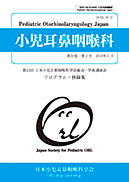Volume 38, Issue 3
Displaying 1-30 of 30 articles from this issue
- |<
- <
- 1
- >
- >|
Editorial
-
2017 Volume 38 Issue 3 Pages Ed1-Ed2
Published: 2017
Released on J-STAGE: March 31, 2018
Download PDF (1271K)
The 12th Conference on Pediatric Otorhinolaryngology Japan
Clinical seminar
-
2017 Volume 38 Issue 3 Pages 231-235
Published: 2017
Released on J-STAGE: March 31, 2018
Download PDF (3876K) -
2017 Volume 38 Issue 3 Pages 236-240
Published: 2017
Released on J-STAGE: March 31, 2018
Download PDF (1908K) -
2017 Volume 38 Issue 3 Pages 241-244
Published: 2017
Released on J-STAGE: March 31, 2018
Download PDF (2201K) -
2017 Volume 38 Issue 3 Pages 245-252
Published: 2017
Released on J-STAGE: March 31, 2018
Download PDF (1951K) -
2017 Volume 38 Issue 3 Pages 253-259
Published: 2017
Released on J-STAGE: March 31, 2018
Download PDF (1591K) -
2017 Volume 38 Issue 3 Pages 260-261
Published: 2017
Released on J-STAGE: March 31, 2018
Download PDF (1537K) -
2017 Volume 38 Issue 3 Pages 262-266
Published: 2017
Released on J-STAGE: March 31, 2018
Download PDF (3507K) -
2017 Volume 38 Issue 3 Pages 267-271
Published: 2017
Released on J-STAGE: March 31, 2018
Download PDF (2468K)
Symposium 1-An approach from upper and lower airways in prolonged cough treatment
-
2017 Volume 38 Issue 3 Pages 272-276
Published: 2017
Released on J-STAGE: March 31, 2018
Download PDF (2674K) -
2017 Volume 38 Issue 3 Pages 277-281
Published: 2017
Released on J-STAGE: March 31, 2018
Download PDF (1597K)
Symposium 2-A diagnosis and treatment of pediatric laryngeal / subglottic / tracheal stenosis
-
2017 Volume 38 Issue 3 Pages 282-290
Published: 2017
Released on J-STAGE: March 31, 2018
Download PDF (3964K) -
2017 Volume 38 Issue 3 Pages 291-296
Published: 2017
Released on J-STAGE: March 31, 2018
Download PDF (5121K) -
2017 Volume 38 Issue 3 Pages 297-301
Published: 2017
Released on J-STAGE: March 31, 2018
Download PDF (1584K)
Pediatric operational seminar
-
2017 Volume 38 Issue 3 Pages 302-307
Published: 2017
Released on J-STAGE: March 31, 2018
Download PDF (5446K)
Morning seminar
-
2017 Volume 38 Issue 3 Pages 308-310
Published: 2017
Released on J-STAGE: March 31, 2018
Download PDF (1589K) -
2017 Volume 38 Issue 3 Pages 311-315
Published: 2017
Released on J-STAGE: March 31, 2018
Download PDF (2250K) -
2017 Volume 38 Issue 3 Pages 316-320
Published: 2017
Released on J-STAGE: March 31, 2018
Download PDF (1762K)
Seminar with sweets
-
2017 Volume 38 Issue 3 Pages 321-325
Published: 2017
Released on J-STAGE: March 31, 2018
Download PDF (1791K)
Luncheon seminar
-
2017 Volume 38 Issue 3 Pages 326-329
Published: 2017
Released on J-STAGE: March 31, 2018
Download PDF (1561K) -
2017 Volume 38 Issue 3 Pages 330-335
Published: 2017
Released on J-STAGE: March 31, 2018
Download PDF (2686K)
Original articles
-
2017 Volume 38 Issue 3 Pages 336-343
Published: 2017
Released on J-STAGE: March 31, 2018
Download PDF (1638K) -
2017 Volume 38 Issue 3 Pages 344-353
Published: 2017
Released on J-STAGE: March 31, 2018
Download PDF (2300K) -
2017 Volume 38 Issue 3 Pages 354-360
Published: 2017
Released on J-STAGE: March 31, 2018
Download PDF (1739K)
Case Reports
-
2017 Volume 38 Issue 3 Pages 361-366
Published: 2017
Released on J-STAGE: March 31, 2018
Download PDF (2035K) -
2017 Volume 38 Issue 3 Pages 367-371
Published: 2017
Released on J-STAGE: March 31, 2018
Download PDF (3171K) -
2017 Volume 38 Issue 3 Pages 372-375
Published: 2017
Released on J-STAGE: March 31, 2018
Download PDF (3075K) -
2017 Volume 38 Issue 3 Pages 376-381
Published: 2017
Released on J-STAGE: March 31, 2018
Download PDF (2711K) -
2017 Volume 38 Issue 3 Pages 382-387
Published: 2017
Released on J-STAGE: March 31, 2018
Download PDF (4839K)
Report of conference
-
2017 Volume 38 Issue 3 Pages 388-390
Published: 2017
Released on J-STAGE: March 31, 2018
Download PDF (6666K)
- |<
- <
- 1
- >
- >|
